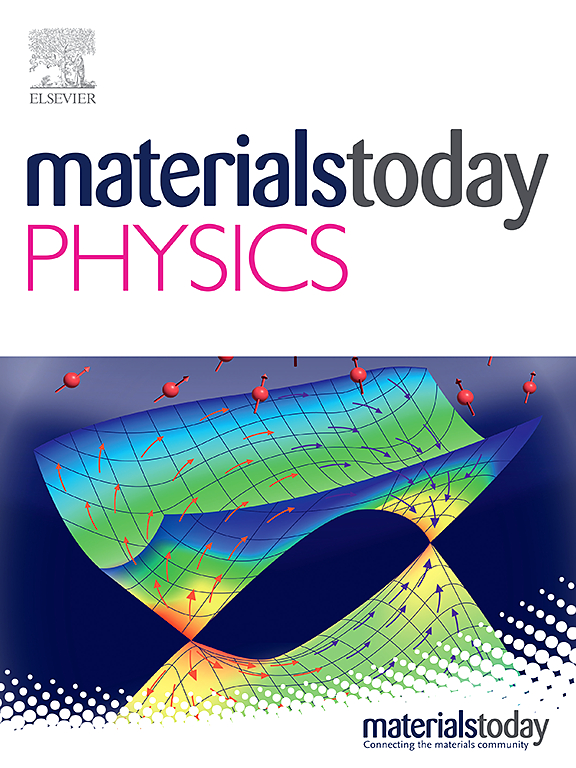Constructing 3D g-CNNS network in epoxy for enhanced thermal conductivity and breakdown strength for high high-voltage applications
IF 9.7
2区 材料科学
Q1 MATERIALS SCIENCE, MULTIDISCIPLINARY
引用次数: 0
Abstract
Ultra-high integration density of power electronics leads to severely localized heat accumulation, critically threatening the safe operation and lifetime of devices. Traditional high thermal conductivity (TC) polymer composites always suffer from deteriorated breakdown strength (Eb). Nowadays, effective decoupling regulation and synchronous enhancement of TC and Eb still is a formidable challenge in polymer composites. To tackle this problematic issue, in this work, the graphitic carbon nitride nanosheet (g-CNNS) was prepared using a thermal oxidation method, and the g-CNNS/cellulose nanofiber (CNF)/epoxy (EP) nanocomposites were prepared via ice-templating and infiltration methods. It is found that the uniformly distributed three-dimensional CNF supporting g-CNNS skeletons were constructed in EP even at low filler loadings. The CNFs can physically crosslink with EP groups and form hydrogen bonds with g-CNNS, not only enhancing the interfacial interactions but also restricting the EP chain mobility, subsequently leading to concurrently improved TC and Eb in g-CNNS/CNF/EP. The 10.4 wt% g-CNNS/CNF/EP exhibits a concurrently high TC and Eb of 1.06 W/(m·K) and 34.7 kV/mm, along with a low permittivity (ε) and dielectric loss (tanδ) of 2.47 and 0.022 at 103 Hz, respectively. This work reveals the underlying heat conduction and charge migration mechanisms, provides deep insight into the design and preparation of EP nanomaterials with simultaneously high TC and Eb coupled with low ε and tanδ, presenting appealing applications in power systems and high frequency microelectronic devices.


在环氧树脂中构建三维g-CNNS网络,以增强高压应用的导热性和击穿强度
电力电子器件的超高集成度导致了严重的局部热积累,严重威胁着器件的安全运行和寿命。传统的高导热聚合物复合材料存在击穿强度(Eb)下降的问题。目前,如何有效地对TC和Eb进行解耦调控和同步增强仍然是高分子复合材料研究中的一个难题。为了解决这一问题,本研究采用热氧化法制备了石墨氮化碳纳米片(g-CNNS),并采用冰模板法和浸渍法制备了g-CNNS/纤维素纳米纤维(CNF)/环氧树脂(EP)纳米复合材料。研究发现,即使在低填料加载下,也能在EP中构建出均匀分布的三维CNF支撑g-CNNS骨架。CNFs可以与EP基团物理交联并与g-CNNS形成氢键,不仅增强了界面相互作用,而且限制了EP链的迁移率,从而导致g-CNNS/CNF/EP中TC和Eb同时得到改善。10.4 wt%的g-CNNS/CNF/EP在103 Hz时具有较高的TC和Eb分别为1.06 W/(m·K)和34.7 kV/mm,介电常数(ε)和介电损耗(tanδ)分别为2.47和0.022。这项工作揭示了潜在的热传导和电荷迁移机制,为同时具有高TC和Eb以及低ε和tanδ的EP纳米材料的设计和制备提供了深入的见解,在电力系统和高频微电子器件中具有诱人的应用前景。
本文章由计算机程序翻译,如有差异,请以英文原文为准。
求助全文
约1分钟内获得全文
求助全文
来源期刊

Materials Today Physics
Materials Science-General Materials Science
CiteScore
14.00
自引率
7.80%
发文量
284
审稿时长
15 days
期刊介绍:
Materials Today Physics is a multi-disciplinary journal focused on the physics of materials, encompassing both the physical properties and materials synthesis. Operating at the interface of physics and materials science, this journal covers one of the largest and most dynamic fields within physical science. The forefront research in materials physics is driving advancements in new materials, uncovering new physics, and fostering novel applications at an unprecedented pace.
 求助内容:
求助内容: 应助结果提醒方式:
应助结果提醒方式:


